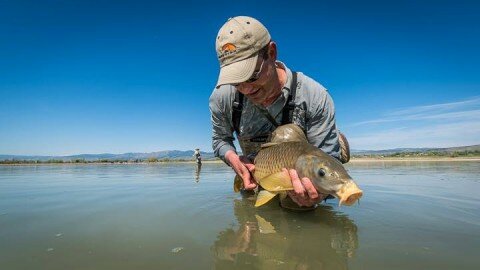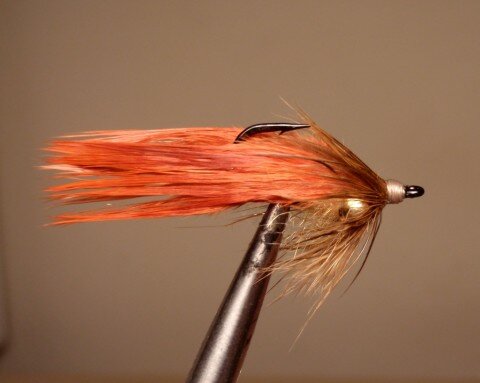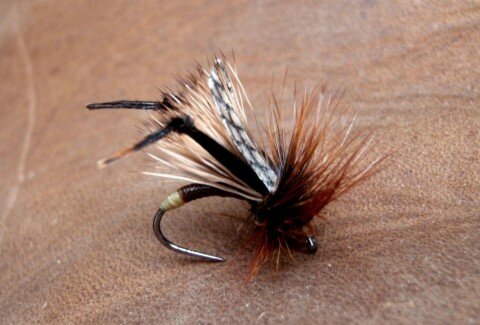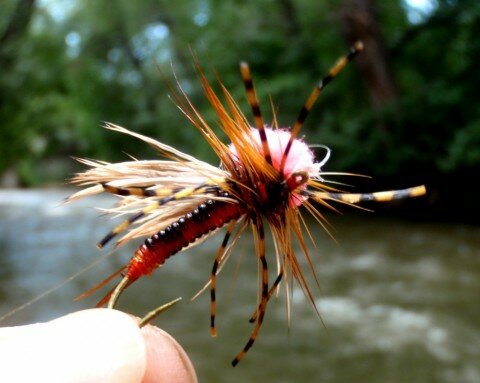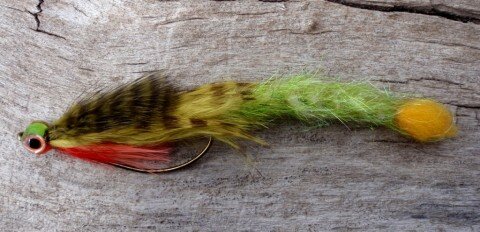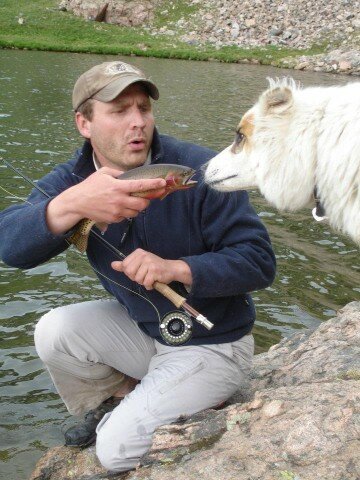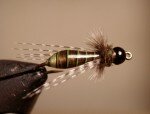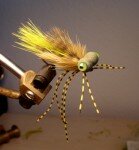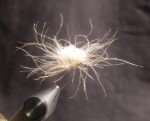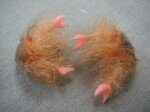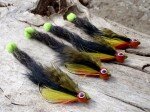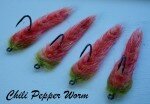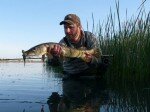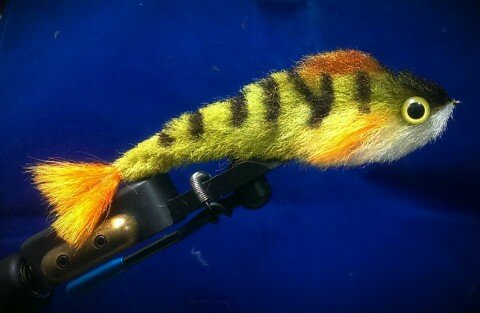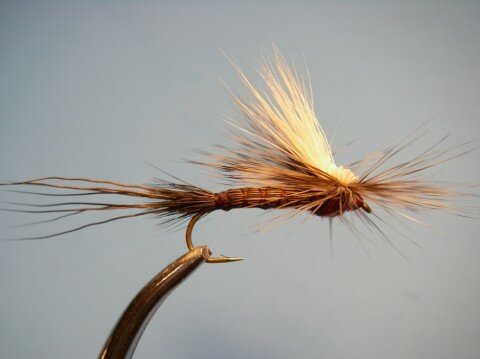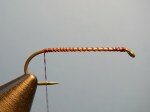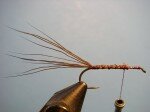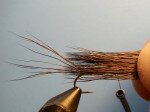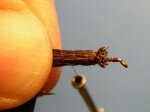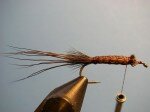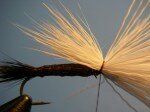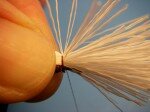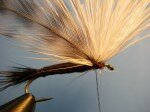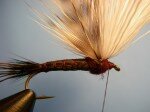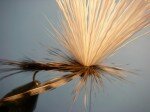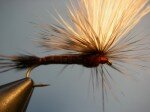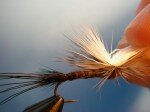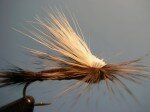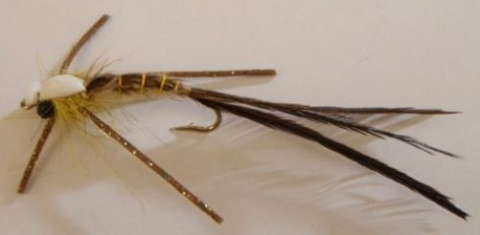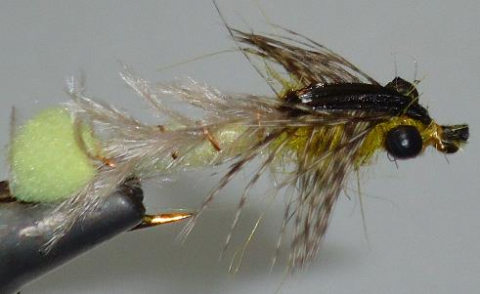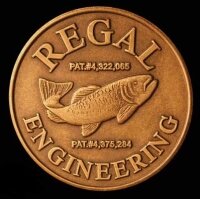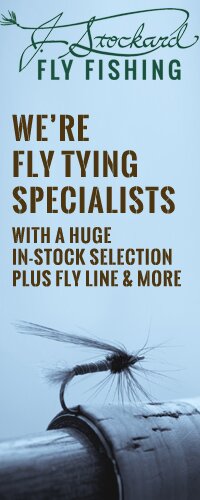Mark is the owner of DeFrank’s Flies & Guide Service located in Uniontown, Pennsylvania. Mark guides along Steelhead Alley in Northeast Ohio and Pennsylvania. He is a very experienced fly tyer, so be sure to check out his other flies on his website. In this video Mark ties a Medusa Mini Intruder used for steelhead.
Monthly Archives: July 2013
Jay Zimmerman interview!
Charlie Craven called you a warm water genius. Do you enjoy fishing for warm water species more than cold water species? What led you to fishing warm water more often?
At the end of every year I look back through my journal and it comes out about even (the time I spend chasing trout vs. warm water species.) I am lucky to have access to several different species within an hour of home. I chase large and smallmouth bass, crappie, perch, wiper, walleye, catfish, northern pike and carp. But I love trout, too. I don’t fish larger rivers or tailwaters much, though. I do the majority of my trout fishing in high alpine lakes and small, remote streams.
Can you tell me more about your fishing experience, how fly fishing entered your life and what you are doing these days?
I was a bored kid and found my father’s old fiberglass rods in the tool shed. They seemed cool. I was about 12 or 13. These days I am working for Charlie Craven in his fly shop (Arvada, Colorado) and working on my third book. This one is a fly tying instructional book on nothing but the best carp flies and how to tie them—most challenging, by far…but the most fun. I am getting a lot of coaching, mainly on photography, from Charlie. He may be the best fly tier and creator of instructional tying books out there, so it is working out in my favor.
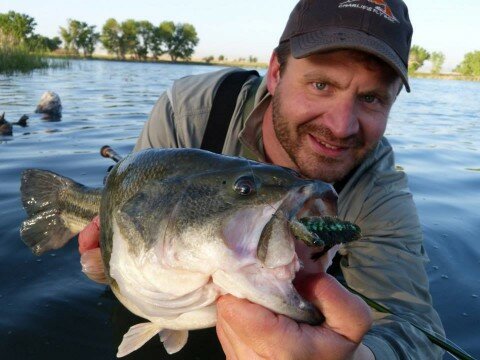 Is there a fish that you’ve caught that has really been memorable?
Is there a fish that you’ve caught that has really been memorable?
No…I guess not. I have such short-term memory, it’s hard. It is why I keep a journal and am so addicted to fishing, I suppose. Got to get back out there and refresh the memory, ya know?
Do you have a favorite species of fish?
Oh, man. That’s hard. Top three might be carp, smallmouth bass and brown trout…not necessarily in that order. No…northern pike, smallmouth and…ah, hell…
How did you obtain your fly tying chops?
Self-taught when I was a kid. Had no idea what I was doing. And I am still learning new shit every day. Yes, it helps that I am surrounded by some of the best fly tiers in the world…
What do you enjoy about fly tying?
I still find it unbelievably cool that fish will eat a lure or fake bug. It does not really seem like it should work at all. The fact that any one of us can sit down at a vise and tie a bunch of fur and feathers onto a hook and go out and catch fish on that thing…still blows my mind. It’s like some magic trick that’s actually real.
What is your thought process when designing a new fly pattern?
Each one is different. Sometimes it is purely a matter of necessity…I need a fly that will work for that stream or for that fish and I can’t find it anywhere so I have to make it. Other times it is attempting to fix a problem…I want a bass frog that floats, rides hook up and has no weed guards…but can skate across moss and shit without hanging up. And other times it is taking a new material or technique and seeing how far I can push it.
I know you like to fish for carp and you have one of the best carp patterns out there in the Backstabber. I’m not sure if “best” sums it up. In my opinion, it has become the benchmark of carp flies. With that said, what makes a good carp fly?
Well, hell…thank you, brother. I don’t think there is an easy answer for that, but I will take a swing anyway. I think a good carp fly must be simple and suggestive—lots of movement. And it has to be exactly the right weight…too light and it will never get to the carp in time, too heavy and the plop into the water will spook the fish. This is more important in the shallow, still water mud flats, of course. Also, I want a fly that is about an inch and a quarter long and dark. I like black because I can see the fly better in muddy water. Seeing the fly and seeing it get eaten is the best way to detect a take, after all.
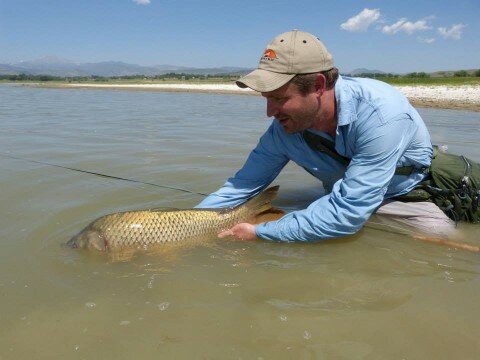 Is there a specific hook you recommend for carp?
Is there a specific hook you recommend for carp?
I am a big fan of the Gamakatsu SL45. I was the first to start using this hook for carp and it has caught on with many of the serious carp guys. The Daiichi 2451 is also good if you like the SL45 but want a bit longer hook shank. But there is nothing wrong with a good ol’ Tiemco 3769 nymph hook, either.
What are some of your favorite flies?
I think a Clouser Minnow may be my favorite fly of all time. One of my new favorites is a Crumpler Cricket…really buggy, sprawling crane-fly-esk legs…fun as hell to fish on small, wild streams.
What type of fly tying vise do you use?
I tie on a Renzetti presentation 4000 with the big base plate. Craven gives me endless grief about this (he likes the Dyna-King Pro) but I would rather use a rusty pair of vice grips welded to a piece of scrap metal than use one of those. He will call me names forever…
Would you describe a couple of your warm water rigs? For example, the size and type of fly rod, line, and leader you use?
My go-to carp rig is a Sage Z-Axis 9ft 6wt and Lamson Litespeed 2 reel with floating line and a 9ft 2x leader with the terminal 12 inches cut off and 18 inches of 3x fluorocarbon tippet, ending in a #6 black backstabber carp fly…
My go-to bass rig is a 9 ½ ft 7wt Sage TCX with a Lamson Litespeed 3 reel with floating line and a 9ft 2x leader with a #2 Texas Ringworm…
If you had to pick 5 dry flies and 5 under water flies to go trout fishing, which ones would you select?
Dry flies: Parachute Adams, Crumpler Cricket, Clown Shoe Caddis, Stimulator and the Missing Link.
Nymphs: Zebra Midge, Two-bit Hooker, Quasimodo Pheasant Tail, Juju Baetis and Banksia Bug.
Are you currently fishing or designing any new fly patterns that you could tell us about?
I am in the final tweaking phase of a new damsel nymph…I have been playing with it for about three years and am just now getting it right. I needed a damsel that was a tiny bit heavier than what was out there, but that would not hang up in the weeds.
Could you explain how your weed guard works on your Texas Ring-Worm?
The Texas Ringworm is the closest thing to a Texas-rigged soft plastic worm a fly tier can tie…it incorporates the long ferruled dubbing loop technique that I perfected to create a real “worm” look and action, coupled with hinged hard-mono loop that allows the big bass hook to actually lock back into the fly while you are casting and fishing it…but disengages when you set the hook. This fly won “Best in Show” at the 2011 IFTD Show. A proud day.
Where can people purchase your flies?
Call me at the shop (303-403-8880) it will be either me, Dave Cook or Charlie Craven picking up the phone. We can send you whatever flies or fly tying materials you need. Our shop has more tying materials than any shop you have ever been in…trust me!
Have you ever kissed a fish? If so, what kind?
When I was single I would make out with fish all the time…especially carp, the have nice lips. Sometimes you just gotta slip the prettier ones a little tongue, too. It feels wrong, but they rarely resist much. Maybe they kinda like it? Who knows?
Jay writes his own blog named the Colorado Fly Fishing Reports. So if you can’t get enough Jay, go there now! Jay’s two previous books are “In Neck Deep: Stories from a Fisherman” and “Top Ten Guide To Fly Fishing”. I want to thank Jay for taking the time to interview with FrankenFly, thanks Jay!
- Boulder Creek Caddis (Clown Shoe)
- Banksia Bug
- Booby Frog
- Clown Shoe Caddis
- Cottonwood fly (for topwater carp action)
- Geezus Lizard (Alaskan)
- Mirror Carp Boulder Colorado
- Raposo Crab
- Texas Ring Worms
- Chili Pepper Worm Fly
Filed under Interview
CDC Sulphur Sparkle Dun – Josh McFadden
This video comes from Josh McFadden at the South Holston River Fly Shop in Bristol, Tennessee. He shows us how to tie a nice CDC Sulphur Sparkle Dun.
Filed under Step by Step, Trout flies
Articulated Fish-Spine – Flymen Fishing Company
Dougie Loughridge got my attention when he posted this one. Inspired by Blane Chocklett’s Gamechanger, this is a Pike size version. Flymen Fishing Company articulated shanks in 20mm and 35mm, Partridge of Redditch universal predator X 4/0 and Funky Fly Tying funky fiber.
What is the Gamechanger you ask? Well, it’s a fly designed by Blane Chocklett using the Flymen articulated shanks. It gives the fly awesome movement and terrific action. Watch the video below and you will see what I’m talking about.
This is using the articulated shank but flies using multiple articulated shanks are chained together and called an Articulated Fish-Spine. To understand this better, visit this page on the Flymen Fishing Company website.
Filed under Streamers
Tilt-Shoot Iso – by Ted Kraimer
The Tilt-Shoot Iso is a pattern I created and have been using the past 10 years with great success. While it isn’t the easiest fly to tie for those unfamiliar with hair body patterns, you will find vast improvements after a number of attempts.
This version of a parachute provides a realistic silhouette of the wing while the pattern sits low in the water for fish to easily see — important when fishing broken water. You can change the body color by changing the thread color to tan or olive, and its worth tying some with a more natural gray color wing/post. Tie this pattern in smaller sizes and you will find it will work as an imitation for a number of mayfly spinners.
Ted’s Tilt-Shoot Iso is available from Rainy’s Flies and can be bought in stocking fly shops. Below are tying instructions for you fly tiers.
Tilt-Shoot Iso – Isonychia Fly Pattern
Hook: TMC 5212 10 – 14
Thread: Uni-6/0 Wine
Tail: Moose Body
Body: Moose Body
Post: Deer Belly Hair – White
Hackle: Grizzly Dyed Dun
Thorax: Fine & Dry Dubbing – Isonychia
- Place hook (size 10) in vise and wrap a thread base from behind the eye to above the barb.
- Cut 6 – 8 moose body hairs, clean and stack/even them and tie in on top of the hook about one hook gape’s distance behind the eye. Tie down along the shank to above the hook barb and back again.
- Cut a large clump of moose body hair (approx. the thickness of two wooden match sticks), clean and stack/even. Measure the hair by laying the clump along the hook where the tips extend just beyond the hook shank. Trim the butt ends so the body will extend from the where we tied the tail in to just beyond the shank.
- Lay the clump of moose along the hook making sure it completely surrounds the hook shank for complete coverage. After a few wraps to secure it in place, hold the moose taught with your left hand as you wrap the thread towards the hook bend with the bobbin in your right hand.
- Take the thread wraps to above the barb and make two tight wraps to secure and then wrap the thread back toward the hook eye crisscrossing the thread wraps making an X pattern. Once secured, trim off any excess butt material.
- Select a clump of deer belly hair for the post/wing (approximately the thickness of three match sticks). Clean and stack/even it. Lay the hair on top of the hook so the natural points extend to the end of the body.
- Tie in the post/wing where the moose body ends and do not trim the butt ends of the hair. Because the hair is hollow it can easily be cut by too much thread pressure.
- Pull both the tips and the butts up and wrap along the shank to encourage the hair to move upward. Tie in a hackle feather at the base of the post/wing with the dull side of the feather facing you. The feather, after being wrapped, should extend to the end of the X-wraps on the body.
- Dub a tight thorax on both sides of the post/wing that is slightly thicker than the body/abdomen also encouraging the post/wing upward.
- Wrap the hackle parachute style under both the tips and butts of the post/wing. Wrap the hackle firmly and it will compress and seat nicely against the post creating a durable hackling.
- Tie off between the hook eye and dubbing.
- Pull the butt ends of the wing/post forward and trim only the butts close to the base, just above the hackle.
- Pull the butt ends of the wing/post forward and trim only the butts close to the base, just above the hackle.
- Apply a drop of thin head cement at the base of the post and the thread head.
- Apply a drop of thin head cement at the base of the post and the thread head.
Filed under Step by Step, Trout flies
Griz’s “Shake & Bake” Hex Emerger
Hook: Size 8 or 10 Natural Curved Hook (TMC 200R, Dai Riki 270)
Thread: 6/0 or 140 Denier Lt. Yellow
Tail: 3 Ostrich Herl Tips – Natural (pulled up as Shell Back)
Rib: Hot Yellow Fine or Medium
Abdomen: Lt. Yellow Dubbing
Wing Case: 1mm or 2mm White Closed Cell Foam
Thorax: Lt. Yellow Dubbing
Legs: Pumpkin Colored Legs
Eyes: Medium Black Mono
Tying Tips:
- You can add weight to the back part of the hook to help aid it to have the bend of the hook ride more vertical
- If you use glitter white foam for the wing case, you may want to coat it with a light coat of Sally Hanson’s Clear.
This fly was in the works for a very long time. I wanted something different for the famed Hex Hatch on the Huron River and this fly does exactly that. While everyone is using the dries this fly as an emerger gets those Smallies attention.
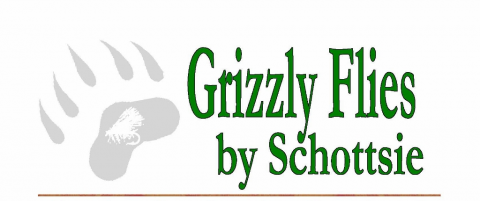
Filed under Trout flies
Griz’s “Frankensteiner” Hex Nymph
Todd sent me this the other day and I thought it was awesome! The fly rocks as well as the name! Check it out!
Tied & Created by Todd A.Schotts
Hook: 700B Dai Riki, Sizes 6, 8, & 10
Thread: 6/0 or 140 Denier, Tan or Brown
Tail: Yellow McFly Foam
Eyes: Black Mono (Large for size 6, Medium for Sizes 8 & 10)
Weight: .25 or .30 (optional)
Rib: Hot Yellow Wire (Medium)
Shell Back: Emu Feathers – Gray or Natural
Abdomen: Pale Yellow Dubbing
Wing Case: Turkey Tail Fibers
Legs: Hungarian soft hackle
Thorax: Golden Stone Yellow Dubbing
This fly came about after wanting my own Hex Nymph, but I wanted something unique. Michigan has some awesome Hex Nymph patterns tied by some famous tiers, so I used parts from 2 different patterns and threw in my own twist to this fly, and what a better name than “Frankensteiner” for this Hex Pattern. And when Paul’s site came about I thought what a better pattern to share on his awesome site.

Filed under nymphs, Trout flies
Regal Revolution Vise Review
For the last month I’ve been able to finally experience what it’s like to tie on a Regal. The model I have been using is their latest, Regal Revolution. Regal Vises are IN-LINE rotary vises. It was very easy to unpack and put together right out of the box. The jaws on this particular vise are the Traditional Head. The other heads available are the Big Game Head and if you want a Midge Revolution, you can custom order it. The Stainless Steel Head is not available for the Revolution.
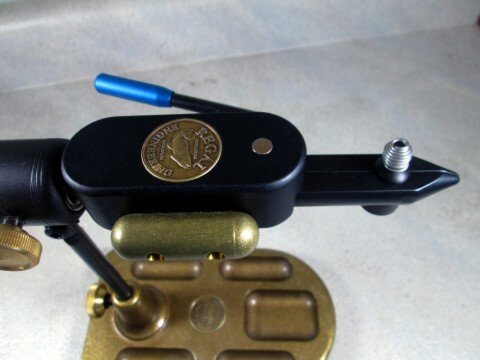 As most of you know that read FrankenFly on a regular basis, I tie all types of trout flies and big streamers for bass. I don’t normally go as large as pike size streamers. The largest flies I tie are for largemouth bass. The Traditional Head handled this without problems. The smallest hook I used was a size 16. The largest hook I used was a 1/0 Mustad 3366 and Gamakatsu size 1 B10S Stinger. I would suggest asking Regal to recommend what Head you should purchase depending on your tying style.
As most of you know that read FrankenFly on a regular basis, I tie all types of trout flies and big streamers for bass. I don’t normally go as large as pike size streamers. The largest flies I tie are for largemouth bass. The Traditional Head handled this without problems. The smallest hook I used was a size 16. The largest hook I used was a 1/0 Mustad 3366 and Gamakatsu size 1 B10S Stinger. I would suggest asking Regal to recommend what Head you should purchase depending on your tying style.
I think the two features that stood out the most were the holding capability of the jaws and the one arm operation of placing a hook in the jaws.
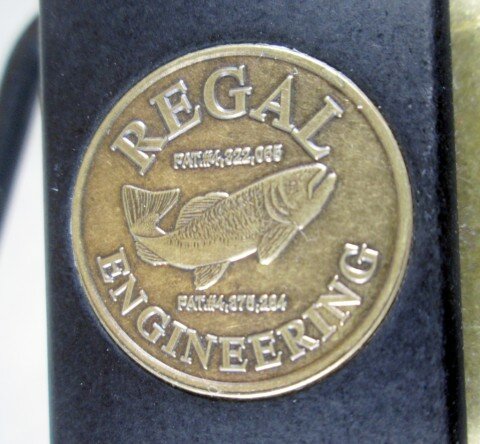 The power of the jaws are honestly top notch. I can really torque down when tying a streamer and the hook stays in place.
The power of the jaws are honestly top notch. I can really torque down when tying a streamer and the hook stays in place.
The one arm operation is just that. You squeeze the lever with one hand, place the hook in the vise and release the lever. Presto, you are ready to start tying! I can see where this would really help the speed of a commercial tyer. You can switch hook sizes without making any adjustments at all. For example on the Traditional Head, you can go from a #22 to a #1/0 without making any adjustments.
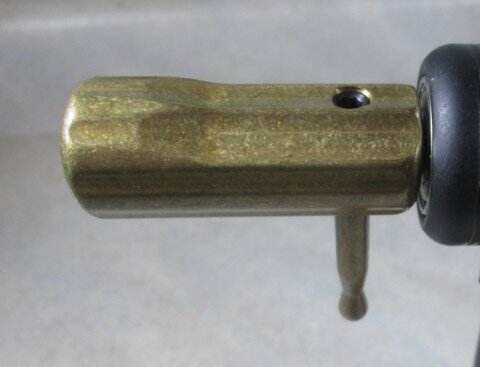 The components of the vise are of good quality. There was nothing flimsy or weak about the vise. The rotary or rotating of the vise can be used by turning the brass handle. I adjusted the pressure with a knob and then I could just reach over and turn the brass handle to rotate my fly. It’s easy to adjust and I like that it isn’t a thin or small knob. Other adjustments can be made to the vise using Allen wrenches that are provided.
The components of the vise are of good quality. There was nothing flimsy or weak about the vise. The rotary or rotating of the vise can be used by turning the brass handle. I adjusted the pressure with a knob and then I could just reach over and turn the brass handle to rotate my fly. It’s easy to adjust and I like that it isn’t a thin or small knob. Other adjustments can be made to the vise using Allen wrenches that are provided.
I have a Regal base for this vise. It’s the model with built-in pockets. It’s heavy duty metal and the pockets are handy to place small flies, beads, extra hooks, etc.
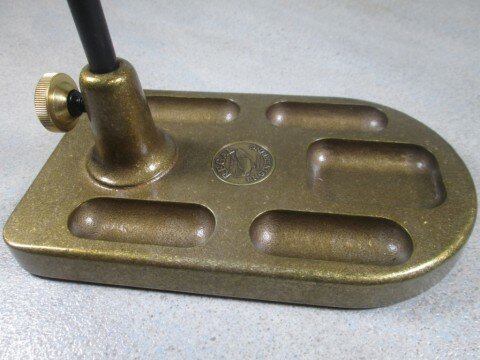
The one thing I didn’t like and was literally in the way, was the material spring near the jaws that is on top of the jaws of the vise. This gets in the way when you’re working with tails on your flies.
However, when I explained this to Michael McAuliffe of Regal he said, “We have redesigned the head so it will no longer have a post or material clip. We will have removable material clips available for purchase. This change will be effective Jan 2014.”
Don’t get me wrong, it can be worked around, but I’m glad to hear about the redesign.
After using the vise for myself, I can see why so many professionals choose a Regal as their main fly tying vise. It’s definitely a top of the line, quality vise, that deserves the reputation it has among professionals. I would highly recommend a Regal Vise for anyone looking for a new vise.
Please visit the Regal Vise website for more information.
Filed under Product Review
Henryville Special
The Henryville Special is an old classic created back in the 1930s by Hiram Brobst. Mr. Brobst was an experienced Pocono fly tyer from Palmerton, PA. His fly was inspired by a sedge pattern he saw in a Europeon fly tying book. He didn’t name the fly and just called it a no-name fly. Years later it was named the Henryville Special after a trout fishing hotel called the Henryville House that sat on Brodhead Creek. Hiram initially designed the fly to imitate caddis flies on Brodhead Creek. It’s such a successful fly that it’s still tied commercially and still used today.
Tightline Productions just released this video on how to tie this classic pattern.
Filed under Step by Step, Trout flies
Brian Wise video – Nick Granato’s Sasquatch
Brian has a brand new video today and it kicks off his series of Nick Granato’s flies. I love Nick’s designs and so this series will definitely be a good one! Brian starts off with one of Nick’s best in my opinion, the awesome streamer, Sasquatch! If you missed it, FrankenFly interviewed Nick a few months back.
If you just can’t get enough of Brian’s video goodness, be sure to check out the new issue of Southern Culture on the Fly magazine. For Issue No. 8, Brian produced a video just for the mag.
Filed under Brian Wise, Step by Step

